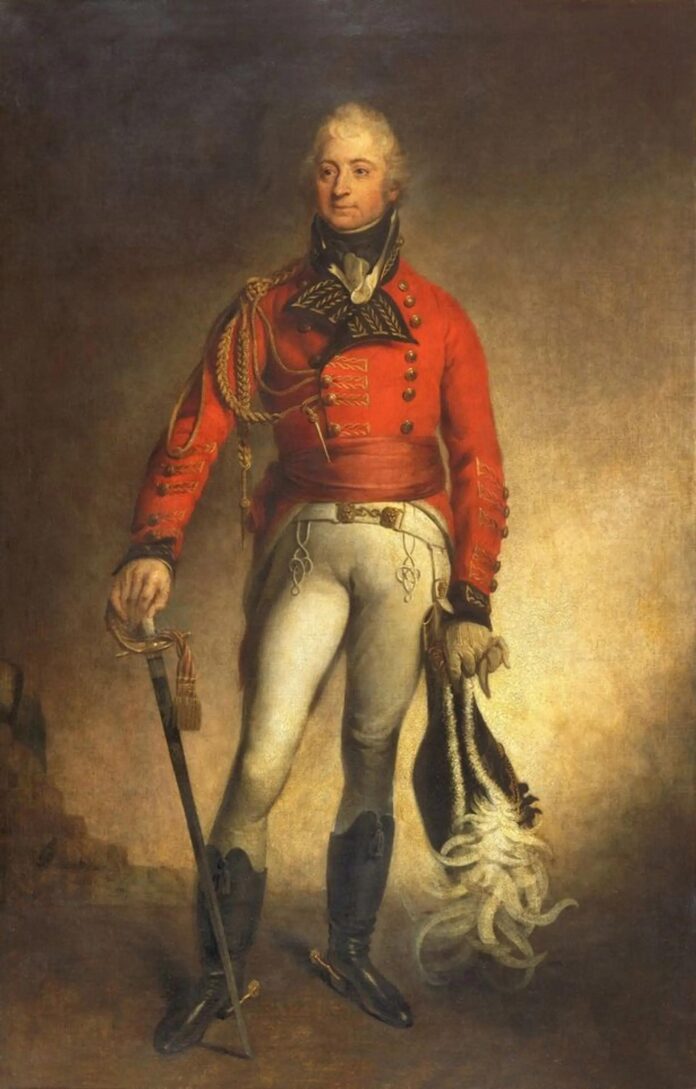A portrait of a Welsh slave owner, which sparked a censorship row last year, has been put back on display at the National Museum Cardiff (Amgueddfa Cymru). But the full-length portrait of Lieutenant-General Sir Thomas Picton is now partially obscured and contained in a travel case with a wooden strut covering the figure’s groin.
The painting by Sir Martin Archer Shee was on display for more than 100 years in the Faces of Wales gallery at the museum but was taken down late last year in the wake of the Black Lives Matter protests. It is now on display in the Reframing Picton exhibition (until September 2023) which provides “additional information and context about Picton’s legacy”, say museum officials in a statement.
The removal of the work prompted the BBC newsreader Huw Edwards to tweet that he felt “uneasy about this element of ‘censoring’ history. Should not Picton remain on display as a reminder to Wales of an aspect of its past—no matter how disgraceful?”. Edwards tells The Art Newspaper regarding the redisplay: “I will visit to see the new ‘context’ before opining.”
Picton was killed in 1815 fighting at the Battle of Waterloo. “[He] has previously been hailed as a public hero but is equally notorious for his cruel treatment of Black enslaved people and free people, and for sanctioning torture during his governance of Trinidad, from 1797 to 1803,” according to a museum statement.
The decision to remove the portrait was made as part of Reframing Picton, a “re-interpretation” initiative organised in collaboration with the community partner, the Sub Sahara Advisory Panel. Two artists with Trinidadian roots—the multi-disciplinary artist Gesiye and the UK-based collective Laku Ne—were subsequently commissioned to “re-frame” Picton’s legacy.
Laku Neg’s work Spirited is an immersive installation comprising a metal sculpture, bamboo frames, found objects and audio-visual elements that reflects the experiences of 14-year-old Luisa Calderón, who was tortured under Picton’s regime. Gesiye invited Black Trinidadians to participate in a “healing offering” that includes a series of portraits and a short film (The Wound is a Portal) based around tattoos that “explore generational trauma in relation to the land”, the organisers say in a statement.
Kath Davies, director of collections and research at Amgueddfa Cymru, says: “We hope that [the artists] spark conversations on representation and the many histories of Wales in a modern-day museum”. The Reframing Picton project team worked with the arts and education charity Culture& on different ways to approach the redisplay, presenting objects such as anti-slavery medals produced in the late 18th century.
The Reframing Piction exhibition is on display in galleries eight, nine and ten at the museum. Asked about the fate of the Picton work once the exhibition ends, a museum spokesperson says: “The portrait will remain as part of Wales’ national art collection and will be kept stored in our specialist art store when not on display. As the piece is a part of Wales’ national collection under Amgueddfa Cymru’s care, the museum will find a new context in which to display the portrait in the future.”

























